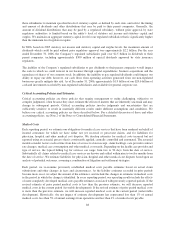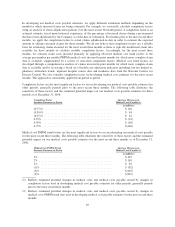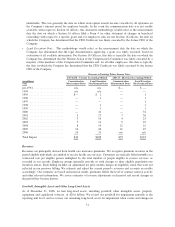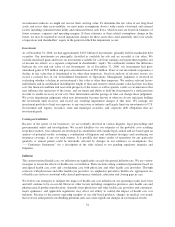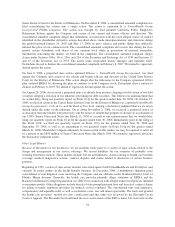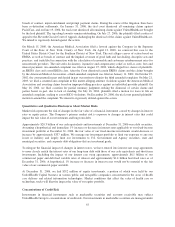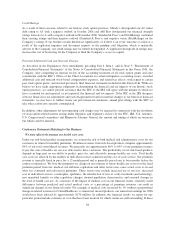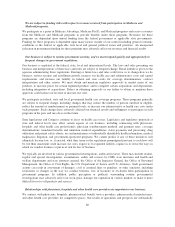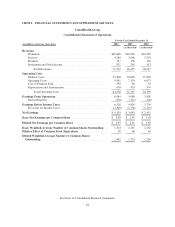United Healthcare 2006 Annual Report Download - page 57
Download and view the complete annual report
Please find page 57 of the 2006 United Healthcare annual report below. You can navigate through the pages in the report by either clicking on the pages listed below, or by using the keyword search tool below to find specific information within the annual report.breach of contract, unjust enrichment and prompt payment claims. During the course of the litigation, there have
been co-defendant settlements. On January 31, 2006, the trial court dismissed all remaining claims against
PacifiCare, and on June 19, 2006, the trial court dismissed all remaining claims against UnitedHealthcare brought
by the lead plaintiff. The tag-along lawsuits remain outstanding. On July 27, 2006, the plaintiffs filed a notice of
appeal to the Eleventh Circuit Court of Appeals challenging the dismissal of the claims against UnitedHealthcare.
We intend to vigorously defend against the action.
On March 15, 2000, the American Medical Association filed a lawsuit against the Company in the Supreme
Court of the State of New York, County of New York. On April 13, 2000, we removed this case to the
United States District Court for the Southern District of New York. The suit alleges causes of action based on
ERISA, as well as breach of contract and the implied covenant of good faith and fair dealing, deceptive acts and
practices, and trade libel in connection with the calculation of reasonable and customary reimbursement rates for
non-network providers. The suit seeks declaratory, injunctive and compensatory relief as well as costs, fees and
interest payments. An amended complaint was filed on August 25, 2000, which alleged two classes of plaintiffs,
an ERISA class and a non-ERISA class. After the Court dismissed certain ERISA claims and the claims brought
by the American Medical Association, a third amended complaint was filed on January 11, 2002. On October 25,
2002, the court granted in part and denied in part our motion to dismiss the third amended complaint. On May 21,
2003, we filed a counterclaim complaint in this matter alleging antitrust violations against the American Medical
Association and asserting claims based on improper billing practices against an individual provider plaintiff. On
May 26, 2004, we filed a motion for partial summary judgment seeking the dismissal of certain claims and
parties based, in part, due to lack of standing. On July 16, 2004, plaintiffs filed a motion for leave to file an
amended complaint, seeking to assert RICO violations. On December 29, 2006, the trial court granted plaintiffs’
motion to amend the complaint. We intend to vigorously defend against the action.
Quantitative and Qualitative Disclosures About Market Risks
Market risk represents the risk of changes in the fair value of a financial instrument caused by changes in interest
rates or equity prices. The Company’s primary market risk is exposure to changes in interest rates that could
impact the fair value of our investments and long-term debt.
Approximately $20.3 billion of our cash equivalents and investments at December 31, 2006 were debt securities.
Assuming a hypothetical and immediate 1% increase or decrease in interest rates applicable to our fixed-income
investment portfolio at December 31, 2006, the fair value of our fixed-income investments would decrease or
increase by approximately $337 million. We manage our investment portfolio to limit our exposure to any one
issuer or industry and largely limit our investments to U.S. Government and Agency securities, state and
municipal securities, and corporate debt obligations that are investment grade.
To mitigate the financial impact of changes in interest rates, we have entered into interest rate swap agreements
to more closely match the interest rates of our long-term debt with those of our cash equivalents and short-term
investments. Including the impact of our interest rate swap agreements, approximately $6.1 billion of our
commercial paper and debt had variable rates of interest and approximately $1.4 billion had fixed rates as of
December 31, 2006. A hypothetical 1% increase or decrease in interest rates would not be material to the fair
value of our commercial paper and debt.
At December 31, 2006, we had $312 million of equity investments, a portion of which were held by our
UnitedHealth Capital business in various public and non-public companies concentrated in the areas of health
care delivery and related information technologies. Market conditions that affect the value of health care or
technology stocks will likewise impact the value of our equity portfolio.
Concentrations of Credit Risk
Investments in financial instruments such as marketable securities and accounts receivable may subject
UnitedHealth Group to concentrations of credit risk. Our investments in marketable securities are managed under
55





